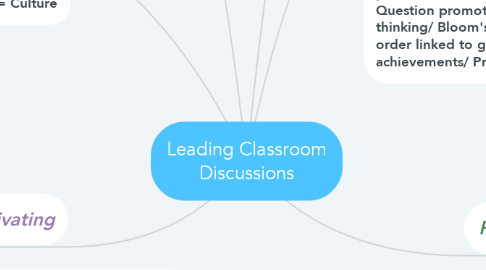Leading Classroom Discussions
by Alisha Kimbro

1. Facilitation / Motivating
2. Student Communication Apprehension
3. Evaluating Your Discussion Skills
4. 1. Structure- Set Knowledge
5. 3. Wait
6. 4. Respond- avoid answering your own question
7. 5. React- reaction will determine the future success or failure of current/ future discussion(s)
8. 2. Solicit- Asking the question
9. Success depends on questions and student's being prepared
10. Discussion prompt challenges students to think beyond text- set knowledge base
11. Unwilling and fearful of sharing knowledge with others
12. Shyness Scale (SS) indicate which students will be highly verbal
13. Helping apprehensive behavior... *vary tasks/ work in small groups/ interpersonal/ be private, personal, provide feedback/ friendly classroom climate/ set ground rules/ engage in get-acquainted exercises
14. Apprehension = Culture
15. 1. Informal Evaluation (Teacher)
16. 2. Informal Evaluation (Student)
17. 3. Video Lesson
18. Choosing The Discussion Method
19. Characteristics Of The Discussion Method
20. Planning The Discussion
21. Advantages: More Heads, More Ideas/ Support Views/ Student Expression
22. Disadvantages: Time, Discussion Skills
23. Experiential Learning: Student's learn best when actively involved in learning/"discover" knowledge through participation
24. Emphasis on Students: Students are the focus/ experiences serve as basis for discussion
25. Critical- Thinking: Students must be competent thinkers/ "right answer" should not be end product, rather inquiring start
26. Questions: Questioning is single most influential teaching practice (what to know & think)/ Question promotes critical thinking/ Bloom's Tax/ Higher order linked to greater achievements/ Probing
27. React: Stifle or enhance discussion process / more support, more motivation
28. Intro : *create *attention *motivate * clarity
29. Body: emphasis is not "what am I going to say?", rather "what questions can I ask that will enable my students to meet the objectives?"
30. Conclusion: *tie entire discussion together * summarize for clarity


